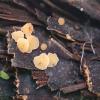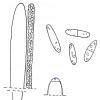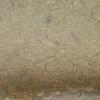
12-11-2025 09:25
 Viktorie Halasu
Viktorie Halasu
Hello, I need help with a pale terrestric Pseudom

11-11-2025 20:16
Bohan JiaHi, lastly I have found these tiny yellow decayin

09-11-2025 13:20
Hello.A tiny ascomycete, appearing as erupting gra

08-11-2025 00:29
 Francois Guay
Francois Guay
I found this species in Quebec, Canada, on herbace
Hymenoscyphus aff. fulvidulus
Nicolas VAN VOOREN,
18-10-2009 20:49
 Bonjour.
Bonjour.Je vous soumets cette récolte effectuée en Corse, sur cône mort de Pinus nigra ssp. laricio.
Apothécies courtement stipitées, Ø 1-3 mm, à hyménium jaune-beige, rougissant dans les blessures ; surface externe concolore, glabre.
Asques sans crochet, 75-92 x 7-8 µm, anneau apical IKI+ (bb). Paraphyses emplies de VBs. Spores elliptiques allongées ou ± ciboroïdes, 12-18 x 3,8-4,2 (4,5) µm, guttulées, avec une cloison sur les spores les plus mûres (hors asque). Excipulum médullaire de textura intricata ; excipulum ectal de textura angularis, mêlé de cellules plus allongées, dont certaines contiennent des VBs.
Il me semble que l'espèce la plus proche serait H. fulvidulus (= Pachydisca fulvidula) mais la teinte semble plus pâle, les spores plus petites, avec une guttulation moins importante.
Qu'en pensez-vous ?
Hans-Otto Baral,
18-10-2009 23:26

Re:Hymenoscyphus aff. fulvidulus
Hi Nicolas
H. fulvidulus has much larger oil drops in the spores. The only idea I have is H. lutescens, but that species I saw only with croziers. Difficult to say. The ectal excipulum would perhaps help, is it angularis almost until margin? Oh I see that lutescens is also excluded because of a t. prismatica on lower flanks:
H. fulvidulus has much larger oil drops in the spores. The only idea I have is H. lutescens, but that species I saw only with croziers. Difficult to say. The ectal excipulum would perhaps help, is it angularis almost until margin? Oh I see that lutescens is also excluded because of a t. prismatica on lower flanks:



